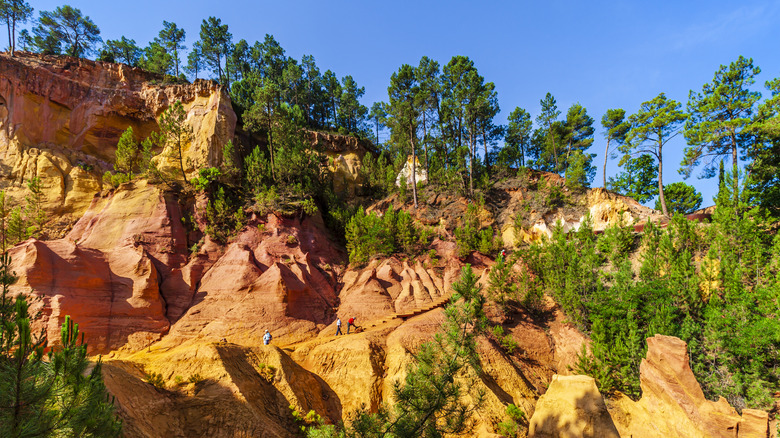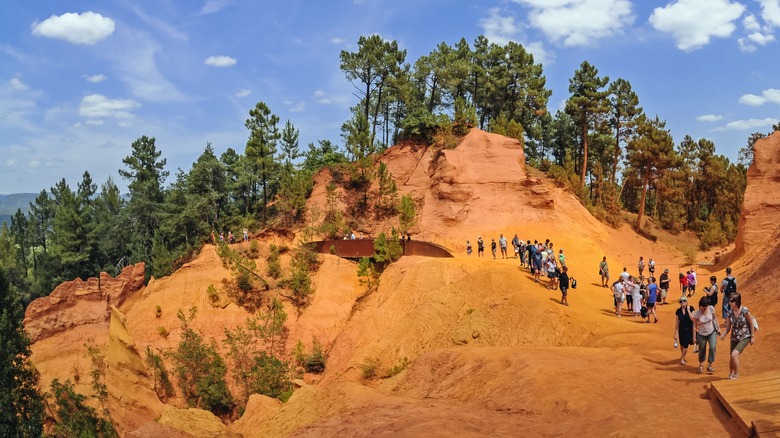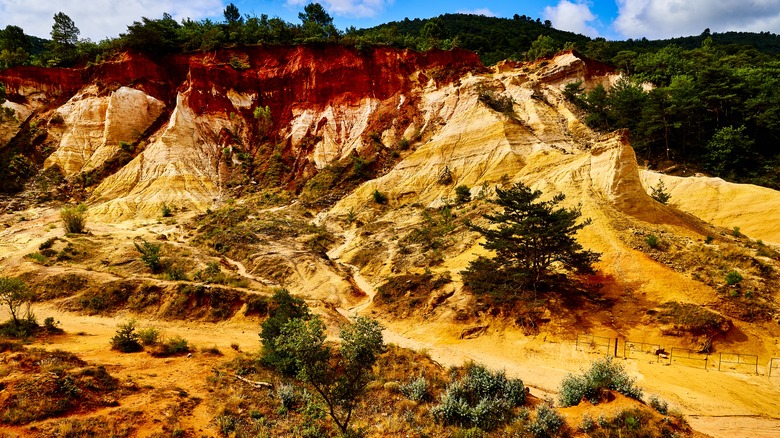This Wildly Underrated French Vacation Destination Has Scenes Straight Out Of The American Southwest
France's Provence conjures images of rolling lavender fields, robust vineyards, and picturesque villages basking in honey-dappled, Provençal light. But this region has some surprises up its sleeve, and that is Roussillon, whose ochre-rich landscapes will have you questioning whether you're still in Provence or have unwittingly been transported to the American Southwest. From its hilltop perch, infused with rich reds, yellows, and oranges, this Provençal gem set in the natural park of Luberon is more than just one of France's most beautiful villages — Roussillon's fame lies in its fiery ochre cliffs and quarries, which are reminiscent of Utah's picturesque Red Rock National Park or Arizona's iconic Monument Valley.
Ochre lies at the heart of this underrated village. As one of the largest ochre deposits in the world, Roussillon's quarries were mined for their rust-colored earth, fueling the area's industrial and economic growth from the late 1700s until 1929, when traditional ochre mining operations slowly declined. The quarries have since closed, but the otherworldly ochre landscape that was left behind continues to attract tourists and visitors to this day.
Positioned between the Vaucluse Mountains and Petit Luberon, Roussillon's quaint village is a good place to base yourself to visit the two trails that traverse the region's breathtaking red-soaked quarries. The first is the Sentier des Ocres (Ochres Trail), which starts from the southern part of Roussillon village, and the second is the Colorado Provençal, which is located in the tiny village of Rustrel, a 25-minute drive away. Set in the charming countryside of the Vaucluse region, Roussillon is just a little over an hour's drive from Marseille Provence airport (MRS). If you opt to take France's high-speed train (TGV), Roussillon is 30 miles from Avignon TGV and 64 miles from Marseille TGV. Departmental buses are few and far between, so renting a car is recommended.
A scenic, ochre-tinged walk through Roussillon's trails
The Ochres Trail is a popular draw for tourists, as the trail conveniently starts in the southern part of Roussillon. The beginning of the trail is announced by a platform offering colorful vistas of ochre cliffs and rocky formations against a backdrop of pine trees and blue sky. You can opt for the shorter trail, a 30-minute walk through a portion of the former ochre quarry's 16-mile span, or venture even further by following the red double arrow-marked 50-minute trail that passes by an 82-foot erosion-sculpted fairy chimney. Both routes are well-marked and irresistibly photogenic, so be prepared for frequent stops to admire the peaceful co-existence of geology and plant life and learn about the site's history displayed on panels along the trail.
While the Ochre Trails make for a delightfully easy afternoon walk, be aware that you'll have to tackle a steep 350-step staircase to access the trail. The sandy terrain also discourages the use of children's strollers. You can visit the Ochre Trail any time of the year, but it is subject to closure in bad weather. The ochre sand will stick and stain light-colored clothing, especially on windy days, so wear dark clothes and footwear. Entrance to the site is $4, and you can also bring leashed pets with you (although white-furred pets may need a bath after walking through the ochre sands). "The Ochre Trail absolutely lived up to my lofty expectations. In fact, I'd go so far as to say it knocked the theme out of the park! The color was breathtaking, the scenery [mesmerizing] and the surrounding village of Roussillon was quintessentially charming," raved blogger LeLongWeekend.
Provençal Colorado is a slice of the American West in Provence
If you're up for a more immersive hike through the ochre landscape formed by years of quarrying, head to the small village of Rustrel (a 12-mile drive from Roussillon) for a hike through the Provençal Colorado. This offers a deep dive into the natural and man-made interventions on the ochre deposits that shaped it into the stunning yet underrated destination it is today. Laden with red, yellow, and white-tinged rock — the result of millions of years' worth of water exposure that triggered chemical reactions — the multicolored site was named Provençal Colorado for its dominant color (red is "colorado" in Provençal) and for its resemblance to Colorado's red-rock reverie of folding cliffs.
Provençal Colorado offers two circuits suited to your ability. Completed in under an hour, the Sahara Circuit traces a leisurely walk with a gentle uphill through the ochre-sculpted cliffs, hills, and valleys of the now-abandoned quarry, unveiling intriguing monuments including a river, a chapel, and blast furnaces along the way. The trail is marked by blue sign posts and stretches 1.3 miles. The longer route of the orange-signposted Belvedere trail (2.4 miles) takes you through more demanding paths but rewards with a breathtaking overlook of the geological formations from a peak altitude of 230 feet. The 2-hour hike passes through the Sahara lookout, Fairy Chimneys, and the White Desert quarry.
With uneven ground and slopes, the site is not wheelchair- or stroller-accessible. Entrance fees depend on your mode of transportation. Like Roussillon's Ochre Trails, pets are allowed on leashes. Open from February to November, the park is best visited during the shoulder months of February to April and September to November. The summer months of May to August require online booking.


